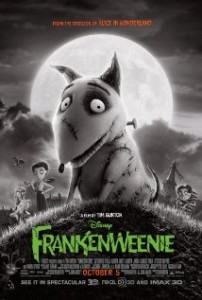Frankenweenie
Posted on October 4, 2012 at 6:00 pm
B+| Lowest Recommended Age: | 4th - 6th Grades |
| MPAA Rating: | Rated PG for thematic elements, scary images, and action |
| Profanity: | Schoolyard language |
| Alcohol/ Drugs: | None |
| Violence/ Scariness: | Ghoulish horror images and some peril |
| Diversity Issues: | Diverse characters |
| Date Released to Theaters: | October 5, 2012 |
| Date Released to DVD: | January 6, 2013 |
| Amazon.com ASIN: | B005LAIIA8 |
 Mary Shelley’s Victor Frankenstein was a scientist who wanted to create life. Tim Burton’s Victor Frankenstein is a kid who just wants his dog back.
Mary Shelley’s Victor Frankenstein was a scientist who wanted to create life. Tim Burton’s Victor Frankenstein is a kid who just wants his dog back.
Writer/director and master of the macabre Burton first developed this idea in a 1984 live action short film that got him fired by Disney because it was too scary for children. Times have changed, and Disney came to Burton to ask him to develop a feature length remake in 3D stop-motion — and in black and white. Burton, who had worked in black and white (“Ed Wood”) and stop-motion animation (“The Corpse Bride,” “The Nightmare Before Christmas”) tells a deliciously ghoulish story with visual wit, panache and a lot of heart.
It is, after all, the story of a boy and his dog. Victor (Charlie Tahan) is a bit of a loner and his dog Sparky is his best friend. When Sparky is killed by a car, Victor decides to harness the power of lightning to try to bring him back to life. At first, it does not seem to work, but then Sparky’s tail starts wagging. And then it wags itself off. “I can fix that!” the happy Victor reassures his re-animated pet. It’s just a matter of a few quick stitches.
One of Victor’s classmates is Edgar “E” Gore (“The Middle’s” Atticus Shaffer), a mishappen but cheerful kid fascinated with creepy things. (His name is “E” Gore, get it?) He pressures Victor to tell him what happened and soon all the kids are trying their own experiments. And then, perhaps because their hearts are not as pure as Victor’s (they want to win the science fair), because they are not as careful and knowledgeable, or just old-fashioned hubris, that is when things begin to go terribly wrong.
This first-ever black and white stop-action animated film is a visual treat with dozens of witty details. I loved it when Sparky’s poodle doggie crush next door (they have a Pyramus and Thisbe-style fence between them) gets enough of an electronic jolt to give her fur white streaks in tribute to Elsa Lanchester’s iconic Bride of Frankenstein. Martin Landau, who won an Oscar in Burton’s “Ed Wood,” gives a delicious performance as Victor’s teacher. Burton’s own pleasure in the twisted and demented is evident in the comic grotesquery of the characters. One creepy little girl insists on seeing omens in her cat’s poop, and when Victor’s classmates try to appropriate his methods, things go bizarrely off-kilter. It does not reach the poetry of “A Nightmare Before Christmas,” but there are plenty of tricks and treats.
Parents should know that this film has ghoulish and macabre themes inspired by classic monster stories, children and adult characters in peril, a sad death of beloved pet, some potty humor, some violence and disturbing graphic images, and some schoolyard language.
Family discussion: How is this story most like the original “Frankenstein?” How is it most different? Which monster is the scariest and why? Why was it hard for Victor to make friends?
If you like this, try: “ParaNorman,” “Monster House,” “Beetlejuice,” and “The Nightmare Before Christmas”
